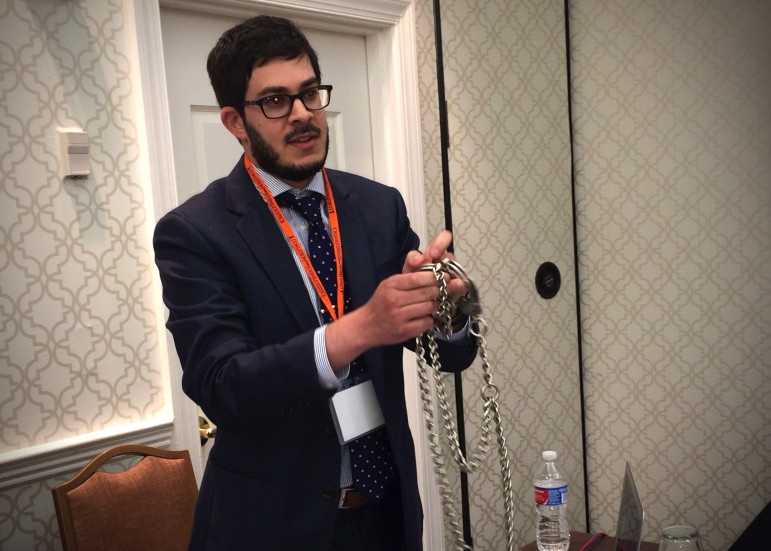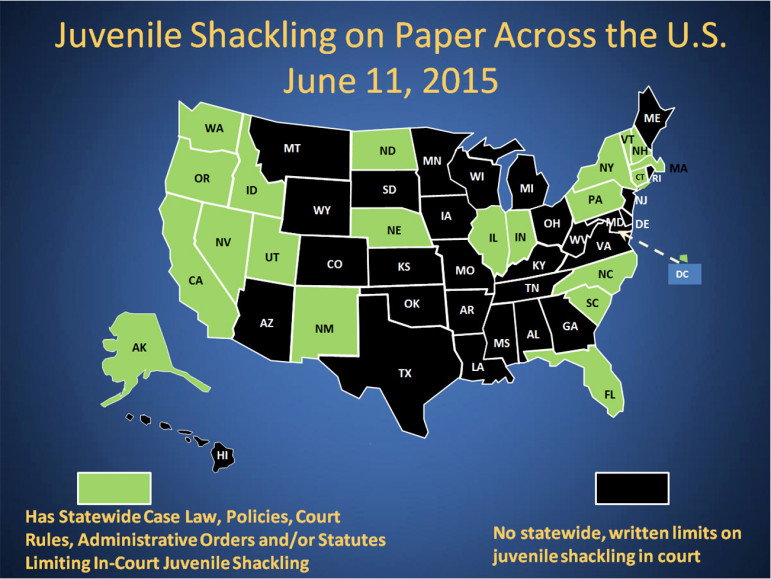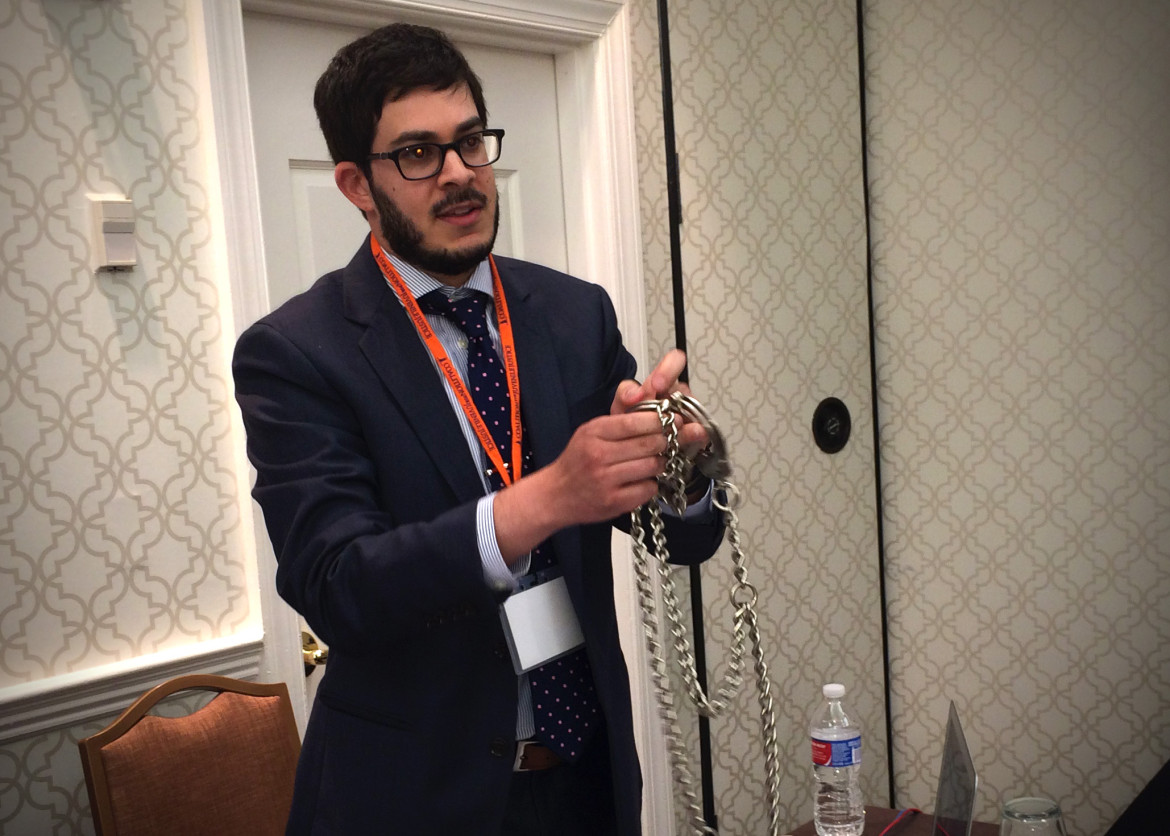
Jamaal Abdul-Alim
David Shapiro, an attorney who heads up the Campaign Against Indiscriminate Juvenile Shackling, holds a set of belly chains and handcuffs during a recent talk about the use of shackles in juvenile court.
WASHINGTON — Shackling young people in court makes court proceedings less fair and also fails to make courtrooms any safer.
So argues attorney David Shapiro, who is leading a campaign against the use of shackles in juvenile court proceedings, at a national conference here. He urged juvenile justice workers to seek reforms that would abolish the practice for all except the most extreme cases.
“One of the things I hear in terms of pushback is: ‘Our jurisdiction is not like theirs,’” Shapiro said of law enforcement and court officials who defend shackling.
He said he responds by pointing to all the states that have successfully banned or curtailed the use of shackles on juveniles without compromising courtroom security.
“So there has to be some jurisdiction where yours matches up with those that have done it,” Shapiro said as he called attention to a map of states that have taken steps to eliminate or reduce the use of shackling in juvenile courts.
Officials in Miami-Dade County in Florida ended indiscriminate shackling in 2006, for example. Since then, he said, 25,000 children have gone through court arraignments and trials unshackled with no escapes or injuries. And in Travis County, Texas, which conducts more than 3,000 detention hearings a year, very few if any children were shackled in 2013 and 2014, yet there were no escapes or injuries, he said.
Shapiro is the campaign manager for the Campaign Against Indiscriminate Juvenile Shackling, a nearly 1-year-old initiative of the National Juvenile Defender Center and the National Campaign to Reform State Juvenile Justice. He spoke last week at the annual conference of the Coalition for Juvenile Justice.
Using actual shackles, handcuffs and belly chains to illustrate his point, he listed a series of negative effects on shackled young people.
For instance, Shapiro said, shackles make it difficult for juveniles in court to talk with their attorneys. Shackles also have a traumatic impact on their sense of self and identity, and lead them to conclude they won’t get a fair shot in court.
“Clients have difficulty believing they’re going to be found innocent until proven guilty when they’re in chains,” Shapiro said.
 Visible shackling also leads judges to view young people as violent and unworthy of trust, Shapiro said. He cited court rulings that have found that visible shackling can bias jurors — something he said can happen to judges too.
Visible shackling also leads judges to view young people as violent and unworthy of trust, Shapiro said. He cited court rulings that have found that visible shackling can bias jurors — something he said can happen to judges too.
“Jurors are people, as are judges,” he said. “There’s no reason a judge would be less biased than a juror.”
The solution, he said, is to stop using shackles except in cases where there is a finding that a specific child is a danger or a flight risk.
“For due process, identity development, adolescent development, rehabilitative reasons, we see that kids’ behavior is better in court when they’re not shackled,” Shapiro said. “They’re more likely to think the process is fair when they are not shackled indiscriminately.”
Young people’s preference to keep the shackles on or off during court proceedings has varied, he said.

Courtesy of the National Juvenile Defender Center
“Some kids are like, ‘I hate being shackled.’ Some say, ‘Leave them on.’ Some kids don’t really care. Some kids want to appear tough in front of friends and family,” Shapiro said. Others, he said, want to keep them on until they realize relatives will see them in chains.
Defense attorneys should always ask their juvenile clients twice if they want the shackles on or off during court proceedings “because kids don’t realize what the alternative means,” he said.
For instance, he said, taking them off will make it easier to write notes and assist their attorney. One audience member suggested the decision should not even be left up to children.
Shapiro also noted how shackles can leave physical scars, such as bruises and lacerations to their arms and legs. But the worst scars, he said, are psychological.
He quoted statements from previously shackled juveniles, such as one who “felt like everybody was looking at me like I was a monster.”
“We hear that word over and over — a ‘monster’ and ‘slave’ and ‘dog,’” Shapiro said. “Kids are trying on different identities.
“They’re identifying with others, and so they’re trying to form self-esteem and trying to form a stronger sense of oneself,” he said. “When they see themselves as animals, as criminals, that’s what their identity becomes.
“It causes psychological harm, especially with kids who have already experienced trauma,” Shapiro said. “We know [children referred to court] are already more likely to experience humiliation or trauma, and shackling can be retraumatizing.
“It can increase the effect of trauma they already experienced in the past.”
Being shackled also increases stress, he said, which can make it hard to focus, recall and express oneself.
“All three are key to helping your attorney help you in court,” Shapiro said.
Shapiro recommended a series of practical steps that juvenile justice workers can take to help end or curtail the use of shackling of juveniles in court.
They include recommendations to:
- Produce language for reform, such as model statutes or model court rules.
- Strategize with associations that are taking the lead against shackling juveniles in their respective states.
- Monitor reforms to make sure everything is running smoothly.
- Try on a pair of shackles in order to get a firsthand feel for what they are like.
- Collect quotes, insights and anecdotes from children and families on the use of shackles.
- Collaborate with stakeholders, both known and unfamiliar.
- Solicit support from the medical community, prosecutors, law school clinics, defender organizations, policy organizations and local bar associations.
“I find that these reforms, everybody can get on board with them,” Shapiro said. Even law enforcement can benefit, he said, because children are more likely to relay valuable information about themselves and others when they are not shackled.
Shapiro said the Campaign Against Indiscriminate Juvenile Shackling can help interested parties with legislative advocacy, conducting courtroom observations and engaging with the media.
Co-panelist Mark Soler, executive director of the Center for Children’s Law and Policy, said the use of solitary confinement — which is deeply ingrained in juvenile justice facilities — should also be seen as unacceptable because of its dehumanizing effects.
He said staff at juvenile justice facilities must be trained to de-escalate situations instead of merely being trained to do “takedowns.”
“Staff also need to be trained in adolescent development so that staff don’t take things personally,” Soler said. “Staff have anxiety about eliminating room confinement because they think they won’t have a way to control kids. This only works if staff understand there are viable alternatives.”
He called for data-driven reforms that examine the frequency of the use of solitary confinement.
“We also think it’s worth looking at whether there are racial or ethnic disparities,” Soler said.
Co-panelist Andrea Weisman, an independent juvenile justice consultant based in Washington, D.C., recounted how a pair of lawsuits triggered reforms in Ohio that led to a 90 percent reduction in the use of seclusion. Previously, she said, young people were “locked down” 23 hours a day in “progress units” where “meals are fed through the slots on their doors, school papers are passed to them through their doors, medical contacts are infrequent and they are offered through the door, so there’s no privacy.”
“Kids scream into the toilet and they can hear it in another cell,” Weisman said. “That’s how kids talk.”
The vast majority of young offenders in Ohio’s “progress units” were African-American, she said, while the vast majority of young offenders sent to mental health units were white.
Now, she said, young people spend no more than four hours in seclusion — in part because experts believe they expend their energy within four hours and no longer pose a threat.
She cited statistics that show 50 percent of all completed suicides in juvenile justice facilities are among youth who are in solitary confinement, and 60 percent of completed suicides occur among youth who have spent some time in solitary confinement.
“People develop psychotic disorders ...” she said. “The harm that accrues is just numerous, and adolescent development is halted and these kids are not faring well.”
Co-panelist Dana Shoenberg, deputy director of the Center for Children’s Law and Policy, said juvenile justice facilities often rely upon solitary confinement because of insufficient staffing and lack of programming, mental health services and know-how on behavior management.
“Teaching kids what behavior is expected and giving them positive incentives works really well,” she said.

Pingback: State Supreme Court Ruling Seals Juvenile Records; News Roundup | Reclaiming Futures
I would be interested in citations of studies that conclude that shackling causes psychological harm.